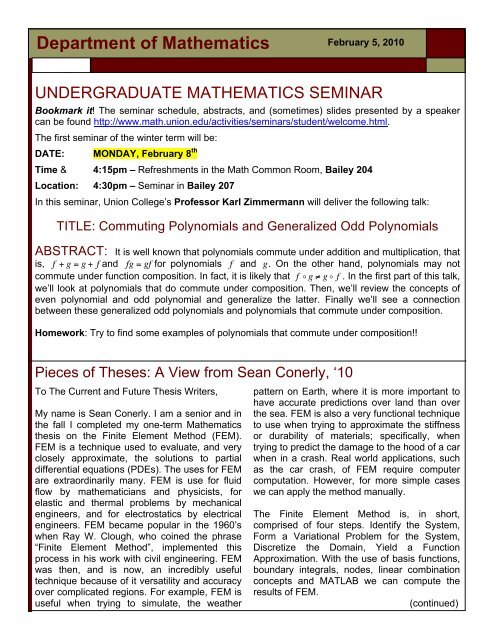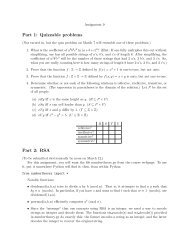Department of Mathematics - Math Department - Union College
Department of Mathematics - Math Department - Union College
Department of Mathematics - Math Department - Union College
You also want an ePaper? Increase the reach of your titles
YUMPU automatically turns print PDFs into web optimized ePapers that Google loves.
€<br />
<strong>Department</strong> <strong>of</strong> <strong><strong>Math</strong>ematics</strong><br />
/<br />
UNDERGRADUATE MATHEMATICS SEMINAR<br />
Pieces <strong>of</strong> Theses: A View from Sean Conerly, ‘10<br />
February 5, 2010<br />
Bookmark it! The seminar schedule, abstracts, and (sometimes) slides presented by a speaker<br />
can be found http://www.math.union.edu/activities/seminars/student/welcome.html.<br />
The first seminar <strong>of</strong> the winter term will be:<br />
DATE: MONDAY, February 8 th<br />
Time & 4:15pm – Refreshments in the <strong>Math</strong> Common Room, Bailey 204<br />
Location: 4:30pm – Seminar in Bailey 207<br />
In this seminar, <strong>Union</strong> <strong>College</strong>’s Pr<strong>of</strong>essor Karl Zimmermann will deliver the following talk:<br />
TITLE: Commuting Polynomials and Generalized Odd Polynomials<br />
ABSTRACT: It is well known that polynomials commute under addition and multiplication, that<br />
is, f + g = g + f and fg = gf for polynomials f and g. On the other hand, polynomials may not<br />
commute under function composition. In fact, it is likely that f � g ≠ g � f . In the first part <strong>of</strong> this talk,<br />
we’ll look at polynomials that do commute under composition. Then, we’ll review the concepts <strong>of</strong><br />
even polynomial and odd polynomial and generalize the latter. Finally we’ll see a connection<br />
€<br />
€<br />
between these generalized odd polynomials<br />
€<br />
and polynomials that commute under composition.<br />
€<br />
Homework: Try to find some examples <strong>of</strong> polynomials that commute under composition!!<br />
To The Current and Future Thesis Writers,<br />
My name is Sean Conerly. I am a senior and in<br />
the fall I completed my one-term <strong><strong>Math</strong>ematics</strong><br />
thesis on the Finite Element Method (FEM).<br />
FEM is a technique used to evaluate, and very<br />
closely approximate, the solutions to partial<br />
differential equations (PDEs). The uses for FEM<br />
are extraordinarily many. FEM is use for fluid<br />
flow by mathematicians and physicists, for<br />
elastic and thermal problems by mechanical<br />
engineers, and for electrostatics by electrical<br />
engineers. FEM became popular in the 1960’s<br />
when Ray W. Clough, who coined the phrase<br />
“Finite Element Method”, implemented this<br />
process in his work with civil engineering. FEM<br />
was then, and is now, an incredibly useful<br />
technique because <strong>of</strong> it versatility and accuracy<br />
over complicated regions. For example, FEM is<br />
useful when trying to simulate, the weather<br />
pattern on Earth, where it is more important to<br />
have accurate predictions over land than over<br />
the sea. FEM is also a very functional technique<br />
to use when trying to approximate the stiffness<br />
or durability <strong>of</strong> materials; specifically, when<br />
trying to predict the damage to the hood <strong>of</strong> a car<br />
when in a crash. Real world applications, such<br />
as the car crash, <strong>of</strong> FEM require computer<br />
computation. However, for more simple cases<br />
we can apply the method manually.<br />
The Finite Element Method is, in short,<br />
comprised <strong>of</strong> four steps. Identify the System,<br />
Form a Variational Problem for the System,<br />
Discretize the Domain, Yield a Function<br />
Approximation. With the use <strong>of</strong> basis functions,<br />
boundary integrals, nodes, linear combination<br />
concepts and MATLAB we can compute the<br />
results <strong>of</strong> FEM.<br />
(continued)
However, in my opinion, more important than what I studied is the thesis process itself. I would be<br />
remiss if I did not warn you about the tedious nature <strong>of</strong> the Thesis process. Unlike any other class<br />
you have taken, your Thesis Presentation is your Thesis Presentation. Therefore, you have to<br />
research everything, you have to derive and be able to clearly explain every step <strong>of</strong> your research<br />
and application. Also, it is really easy to fall behind and to feel lost. Therefore, procrastination<br />
cannot be an option and will surely negatively impact the quality <strong>of</strong> your presentation. Do not panic,<br />
this is typical. Simply continue to work hard and trust that your hard work will, in fact, pay <strong>of</strong>f<br />
greatly.<br />
In closing, as scary as all <strong>of</strong> this may sound, I have benefitted greatly from the thesis process. I<br />
definitely feel I manage my time more efficiently. More importantly, I gained a completely new and<br />
relevant set <strong>of</strong> knowledge about a topic I never knew existed. I hope that your experience with<br />
thesis will be as beneficial as mine was. Good luck, and remember that it is not about how much<br />
you have to stress or how lost you feel, it is about your ability to, simply, persevere.<br />
Record Number <strong>of</strong> Digits <strong>of</strong> Pi Calculated<br />
As reported by the BBC News<br />
(http://news.bbc.co.uk/2/hi/technology/8442255.stm), Fabrice<br />
Bellard claims to have computed the first 2.7 trillion digits <strong>of</strong> pi,<br />
establishing a world record. The record setting computation<br />
took 131 days on a desktop computer to complete and check.<br />
The previous record, some 123 billion digits less than what<br />
Bellard calculated, was set using a supercomputer in Japan<br />
that is 2000 times faster than the desktop used in this recent<br />
work and required only 29 hours <strong>of</strong> computing time.<br />
Problem <strong>of</strong> the Newsletter: February 5, 2010<br />
Congratulations to recent <strong>Union</strong> graduate, Andy Mackenzie ‘09 for correctly solving last week’s Problem <strong>of</strong><br />
the Newsletter, and an honorable mention to Tomas Kourim for progress toward a solution. Andy’s<br />
winning solution has been posted on the bulletin boards in Bailey Hall.<br />
Here is this week’s problem: Andy Mackenzie had so much fun with last week’s Putnam Exam problem<br />
that he suggested this week’s problem should be another Putnam Exam problem from a while back that he<br />
enjoyed playing with. Here it is.<br />
A Dyck n-path is a lattice path <strong>of</strong> n upsteps (1,1) and n downsteps (1, -1) that start at the origin O and never<br />
dips below the x-axis. A return is a maximal sequence <strong>of</strong> contiguous downsteps that terminates on the xaxis.<br />
For example, the Dyck 5-path illustrated has two returns, <strong>of</strong> length 3 and 1 respectively. Show that<br />
there is a one-to-one correspondence between Dyck n-paths with no return <strong>of</strong> even length and the Dyck (n-<br />
1)-paths.<br />
Pr<strong>of</strong>essor Friedman will accept solutions to this problem until 12:00 noon Thursday, February 11 th . Email<br />
your solution to him (friedmap@union.edu) or put it in his mailbox in the <strong>Math</strong> <strong>of</strong>fice in Bailey Hall.<br />
Page 2



